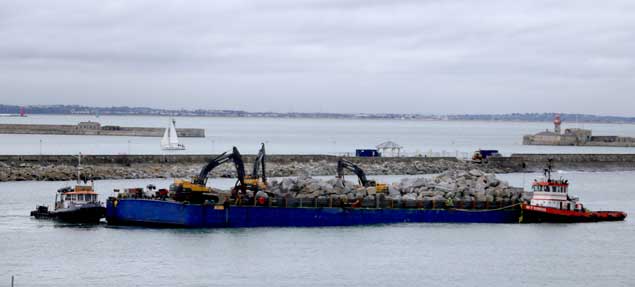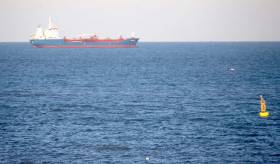Displaying items by tag: Scotsman's Bay
Man Rescued from Scotsman's Bay by Rescue Services
Rescue services rescued a man from off Dun Laoghaire Harbour on Sunday afternoon (August 13th).
Coastguard Rescue Helicopter 116, Dun Laoghaire Harbour RNLI, the local Coastguard unit, and nearby pleasure craft were all involved in rescuing a man 'treading water' in Scotsman's Bay.
 Coastguard Rescue Helicopter 116 - operating over Dun Laoghaire in the search and rescue of a man in the water in the south of Dublin Bay Photo: Afloat
Coastguard Rescue Helicopter 116 - operating over Dun Laoghaire in the search and rescue of a man in the water in the south of Dublin Bay Photo: Afloat
After a search that began at Sandycove Point and the Forty Foot Bathing Place, local yachts and Rescue 116 located the man in the middle of Scotsman's Bay, who was retrieved from the water by Dun Laoghaire Harbour RNLI's inshore lifeboat.
The lifeboat requested an ambulance to meet it on its return to the Harbour with the casualty.
Works Begin to Bring Boulders to Scotsman's Bay Site of New Jetty at Redeveloped Dun Laoghaire Baths
#DublinBay - Works on the redeveloped Dun Laoghaire Baths project at Newtownsmith reached a significant milestone given the arrival this morning by sea of the first load of rock armour to protect a newly built jetty, writes Jehan Ashmore.
As Afloat previously reported a consignment of huge granite boulders arrived last month into Dun Laoghaire Harbour by barge since identified as the Selina. The rock armour loaded in Falmouth, Cornwall, has remained in the Irish port for almost a fortnight but is now ready to be installed to protect the new Scotsman's Bay jetty quay from erosion.
The jetty forms part of the Dun Laoghaire Baths site and is Dublin Bay's newest quay for swimming and fishing. In addition, the facility is also intended to be an embarkation point for small boats and canoes setting off into Scotsman's Bay, located between the harbour's East Pier and Sandycove. The public amenity project for Dun Laoghaire Rathdown County Council was contracted to SIAC Construction, while the design was carried out by DLR's Architects' Department, which will see a new public café linked to an outdoor terrace with views over both bays, along with studio workspaces for artists and new lifeguard facilities.
At 84m long Selina and with a beam of 20m the barge was towed by Wicklow based Alphamarine's Husky at the stern while Brixham based Marine & Towage Services MTS Indus took charge at the bow. In addition, prior to departing Dun Laoghaire Harbour, a pilot from Dublin Port Company cutter Liffey embarked to assist operations that saw the flotilla round the East Pier into Scotsman's Bay where the workboats are in close proximity of the rocky coastline.
 Tugs Husky and MTS Indus with barge Selina offload rock armour in Scotsmans bay Photo: Afloat.ie
Tugs Husky and MTS Indus with barge Selina offload rock armour in Scotsmans bay Photo: Afloat.ie
According to Dun Laoghaire Rathdown County Council, the rock armour will be stockpiled adjacent to the new jetty until it is ready to be placed into a more precise allocation. This will require off-loading of the barge by using several diggers on board, however, the operation only be carried out typically during a 3 to 4-hour window at high tide level. The operation may take between 3 to 4 high tide cycles before the work is completed to surround the jetty that is weather permitting expected to take a fortnight to complete.
DLRCoCo added during the rock armour process, there may be increased noise levels in the off-loading operations and that they apologised for any inconvenience this may cause.
Wave Generator Test Buoy Deployed in Scotsman's Bay
The Commissioners of Irish Lights have deployed a temporary buoy in Scotsman’s Bay in south of Dublin Bay.
The buoy has been deployed to test a wave generator system. The buoy is an IALA Special Mark, yellow in colour, bearing a yellow ‘X’ topmark with the light characteristic Fl.Y.5s.
The buoy is located on the following position: Latitude 53°17.519’N, Longitude 006°07.136’W, a location in an area where Dublin Bay Sailing Club will set marks for their Summer Season starting in April.
The Commissioners of Irish Lights buoy will be on station for approximately 3 months, according to a Dublin Port Company notice from Harbour Master Michael McKenna that is downloadable below.
Match Racing Challenge Hot Seat a Pricey Gift
You could be in the hot seat at next month's International Match Racing Challenge - provided you'e got €200 to spend.
The top-level entertainment package for the Royal St George Yacht Club's second annual event, set for the weekend of 23-24 July, will put yacht racing fans on board with a team "experiencing the thrills and tension of the race as it happens along with the competitors".
A spectator package - which will set fans back €100 - gives a bird's-eye view of all the racing in Scotsman's Bay "as well as the added bonus of firing the starting gun", according to the RSGYC.
The second International Match Race Challenge will see Ireland’s top six match racing teams go head to head against a world team consisting of six international crews from France, Germany, Australia, New Zealand and the UK. Ireland will be hoping to avenge their 36-29 loss to the world at last year's inaugural event.
Match racing involves head-to-head racing between two identical boats over short 20 minute courses, with each boat having four crew members. At the end of the competition and after approximately 90 races, there will be an overall individual winner. In addition, the combined scores of the six Irish teams and the six international teams will deliver an overall team winner.
Package One
THE HOT SEAT
€200 per person
Experience the thrills and tension of the race as it happens aboard!
12:00 Meet and Greet in Club
12:30 Race Briefing and Intro to the Event
12:45 Light Lunch
13:30 Trip on Yacht around Dublin Bay
14:30 Arrive at Spectator area to watch racing
15:00 Hot Seat Race
16:15 Return to shore
16:30 BBQ and Drinks
Hot Seaters need to be prepared to get wet and be active!
Package Two
PURE SPECTATOR
€100 per person
Get a Bird's Eye view of all the action!
12:00 Meet and Greet in Club
12:30 Race Briefing and Intro to the Event
12:45 Light Lunch
13:30 Trip on Yacht around Dublin Bay
14:30 Arrive at Spectator area to watch racing
15:00 Step on Board the Starter's Boat and fire the Starting Gun
16:00 Return to shore
16:30 BBQ and Drinks
SB3s Plan Further Expansion with Dun Laoghaire Open Day
New sailors are invited to try a sail on the 'one design performance boat' in a special Open Day on Saturday, 9th October between 1030 and 1600. Registration begins at 9.30am.
Boats will be alongside at the National Yacht Club in the harbour for demo runs and class members will be available to discuss the Sportsboat design.
The recent SB3 Nationals staged in Howth this month attracted a fleet of 48 boats racing with attendance from all the major Irish sailing centres. Internationally Ireland sends a team to the World championships and the inaugural world championships were held here in Dun Laoghaire in 2008 with a massive fleet of 137 boats.
The class association will organising sailing in Scotsman's Bay on October 9th with RIB transfers to the boats. Experienced or novice sailors are all invited to participate. Those wishing to sail ideally should advise the organisers first of their time slots and make sure they bring their sailing wet weather gear and a life jacket. Short races will also be run to allow visitors get a feel of the boats.
To make a provisional booking, please call or text Justin on 087 2417542
























